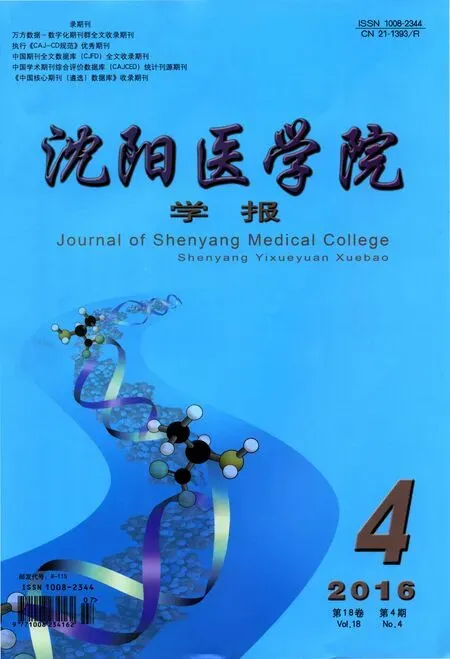细胞信号转导通路在胶质瘤侵袭及迁移中的作用
葛瑞祥,毛捷(皖南医学院弋矶山医院神经外科,安徽 芜湖241001)
细胞信号转导通路在胶质瘤侵袭及迁移中的作用
葛瑞祥,毛捷*
(皖南医学院弋矶山医院神经外科,安徽芜湖241001)
胶质瘤为中枢神经系统最常见的肿瘤,现阶段治疗方式为外科手术治疗为主,术后联合放化疗。胶质瘤具有高度的侵袭能力,在颅内呈弥漫性生长,是治疗失败的主要原因。随着基因和分子生物学的发展,胶质瘤侵袭的分子机制逐渐被人们认识。多种信号通路参与胶质瘤的侵袭与迁移,有望成为药物治疗潜在的作用靶点。
胶质瘤;信号通路;侵袭;迁移
doi:10.16753/j.cnki.1008-2344.2016.04.024
[Abstract]Glioma is the most commonly diagnosed central nervous system tumors.The standard treatment for glioma is combination of surgery,radiotherapy and chemotherapy.The main cause of the treatment failure is the highly invasive and diffusely infiltrative nature of glioma.With the development of genetics and molecular biology,signaling mechanisms that drive glioma invasiveness has been recognized.Varioussignalingpathwaysareinvolvedindevelopmentofglioma,andhaveemergedaspromisingtherapeutictargets.
[Key words]glioma;signaling pathway;invasion;migration
神经胶质瘤起源于神经上皮细胞,为神经系统中最常见的肿瘤,约占颅内原发性肿瘤的40%~50%[1]。胶质瘤细胞具有高度的侵袭能力,在脑实质中呈弥漫浸润性生长,手术难以做到完全切除,术后患者不可避免地出现复发[2]。侵袭、迁移是胶质瘤重要的生物学特性,是多基因调控、多步骤发展的过程。此过程涉及胶质瘤细胞之间、胶质瘤细胞与细胞外基质(extracellular matrix,EMC)之间的相互作用,主要包括:(1)肿瘤细胞自原发部位分离;(2)通过黏附作用结合EMC;(3)肿瘤细胞分泌的蛋白酶降解EMC;(4)肿瘤细胞的形态发生改变,发生细胞骨架重构。以上各步骤中胶质瘤细胞高度侵袭性和增殖性等恶性表型,都证实与多种信号转导通调控密切相关。本文对参与胶质瘤侵袭、迁移的恶性生物学过程相关信号通路进行综述。
1 转化生长因子β-(TGF-β)信号通路
TGF-β是一种生物效应多肽类细胞因子,与众多细胞因子和生长因子共同调节着细胞的生长和分化。TGF-β信号通路通过其下游Smads蛋白,将细胞外信号由胞膜转入细胞核内,发挥着广泛的功能作用[3]。一方面TGF-β在正常机体内能抑制细胞增殖、诱导细胞凋亡和调控细胞的自噬,起到抑制肿瘤发生的作用。另一方面,TGF-β在肿瘤发展过程中,却发挥着促进肿瘤发展的作用[4]。TGF-β信号通路主要通过调控Snail、ZEB和bHLH 3种转录因子诱导上皮间质转化(epithelial mesenchymal transition,EMT),改变肿瘤细胞及其生长环境,影响肿瘤发生发展进程。在EMT过程中,起源于神经上皮的胶质细胞逐渐丢失上皮细胞特征,通过去分化转变为运动能力更强、抗失巢凋亡的细胞,而具有侵袭能力,在胶质瘤细胞的浸润和迁移过程中起枢纽作用[5]。越来越多的证据表明,TGF-β通路异常激活和胶质瘤细胞的侵袭、迁移能力密切相关[6-7]。
研究发现,激活胶质瘤中TGF-β信号转导通路,可使钙粘素(E-cadherin)的表达降低,促进胶质瘤细胞的侵袭、迁移[8]。E-cadherin是上皮组织中一类依赖Ca2+的细胞间黏附分子,它可以与胞内的连环素(β-catenin)结合形成复合体,连接于肌动蛋白细胞骨架上,维持细胞间黏附的稳定。E-cadherin表达下调是EMT最重要的特征之一,当E-cadherin表达下调,上皮细胞间的细胞黏附将不稳定,转变为类似具有移行能力的间质细胞。Liu等[9]研究发现,TGF-β1能够抑制E-cadherin的表达,使参与细胞运动和基质降解的波形蛋白(Vimentin)和基质金属蛋白酶2 (MMP-2)过表达,认为TGF-β1能通过诱导胶质瘤细胞EMT,提高神经胶质瘤细胞的侵袭能力。
2 PI3K/AKT信号通路
PI3K家族是一类能特异催化磷脂酰肌醇的脂质激酶,它们通过不同的信号转导途径,调节细胞增殖、分化、侵袭、迁移和新陈代谢。AKT是信号转导通路中重要的蛋白激酶,为PI3K下游的靶蛋白,是信号转导通路中的核心,其持续活化与肿瘤的发生发展密切相关。PI3K特异性地使磷脂酰肌醇环上的3位羟基磷酸化,生成3,4,5-三磷酸磷脂酰肌醇(phosphatidylinositol(3,4,5)triphosphate,PIP3),而第10号染色体缺失的磷酸酶与张力蛋白同源(phosphatase and tensin homolog,PTEN)能使PIP3去磷酸化[10-11]。PIP3能与信号蛋白AKT和PDK1(phosphoinositide dependent kinase-1)结合,促进PDK1磷酸化AKT蛋白的Ser308导致AKT活化,活化后的AKT通过激活其下游因子而产生一系列的生物效应[12]。现已发现,多种肿瘤发生过程中出现PTEN突变、缺失和PI3K过表达而导致PI3K/AKT信号通路过度活化现象。在胶质瘤中,异常活化的PI3K/AKT通路通过调控基质金属蛋白酶类(matrix metalloproteinases,MMPs)活性,影响胶质瘤侵袭、迁移能力。
胶质瘤细胞突破EMC是发挥侵袭、迁移作用的关键步骤,ECM降解为胶质瘤的生长提供空间,是胶质瘤细胞侵入正常脑组织的有利条件[13-14]。MMPs在EMC的降解过程中发挥重要作用,影响着胶质瘤侵袭、迁移过程。MMPs在胶质母细胞瘤中的表达不仅明显增高,且在胶质瘤中的表达水平与胶质瘤级别相关,这说明MMPs在胶质母细胞瘤侵袭、迁移过程中发挥重要作用[15-16]。Kubiatowski等[17]通过RT-PCR及Western blot实验发现,随着C6胶质瘤细胞系中PI3K表达增高,MMP-2及MMP-9的表达随之降低,认为PI3K/ AKT通路可调控MMP-2和MMP-9在胶质瘤中的表达,影响胶质瘤细胞的侵袭能力。有研究发现,抑制PI3K/AKT信号通路的激活,可阻断MMP-9启动子区域与核因子κB(NF-κB)和AP-1结合,下调MMP-9的表达,抑制胶质瘤细胞的侵袭能力[18]。值得注意的是,PTEN能够使PIP3去磷酸化,可抑制AKT的活化。Koul等[19]研究发现,PTEN能抑制PI3K/AKT通路的激活,下调MMP-2在胶质瘤中的表达水平,抑制胶质瘤的侵袭、迁移。
3 Wnt信号通路
Wnt信号传导通路在胚胎发育和维持内环境稳态中扮演重要的角色,其中包括经典型Wnt信号通路和非经典型Wnt信号通路。经典型Wnt/ β-catenin通路是现阶段研究较为深入的信号通路。当Wnt/β-catenin信号通路尚未激活时,糖原合成酶激酶-3β(GSK-3β)、APC(adenomatous polyposis coli)和轴蛋白(Axin)等蛋白一起组成的β-catenin降解复合体,通过磷酸化胞质中游离的β-catenin,使细胞中的β-catenin保持在较低的水平。当Wnt配体与细胞膜上的卷曲蛋白(Frizzled,Fzd)受体结合后,Wnt信号通路被激活,在胞质内的散乱蛋白(Dvl)作用下使降解复合体解聚,引发细胞浆中β-catenin的聚集,β-catenin进入细胞核后与T细胞因子(T-cell factor,TCF)、淋巴细胞增强因子(lymphocyte enhancer factor,LEF)结合,激活下游靶基因c-Myc、细胞周期蛋白D1(Cyclin D1)和MMPs的转录[20]。研究发现,Wnt/β-catenin信号通路的激活与胶质瘤细胞侵袭能力密切相关[21]。Kahlert等[22]通过免疫组化法发现,30例胶质母细胞瘤组织中β-catenin表达高于瘤周组织,认为Wnt/β-catenin通路与肿瘤细胞的运动能力直接相关,进一步研究发现,Wnt/β-catenin信号通路激活后,能上调诱导EMT相关转录因子(ZEB1、Twist、Snail and Slug),增强胶质母细胞瘤细胞系体外侵袭能力。
非经典型通路包括Wnt/Ca2+、Wnt/JNK和Wnt/ Ryk等信号转导通路[23]。Wnt5a是非经典型通路Wnt蛋白家族的成员,能激活β-catenin非依赖信号途径。有研究发现,胶质瘤患者病理组织中高表达Wnt5a,且Wnt5a阳性表达程度与胶质瘤临床级别呈正相关[24]。Mika等[25]在研究中发现,Wnt-5a在胶质瘤中过表达,Wnt-5a通过上调MMP-2表达降解或重构ECM,增强胶质瘤细胞系的侵袭能力;而下调Ryk蛋白表达能抑制MMP-2的活性,认为Ryk发挥抑制胶质瘤的侵袭能力作用。
4 有丝分裂原激活的蛋白激酶(mitogen activated protein kinases,MAPK)信号通路
MAPK信号通路是广泛存在真核细胞内的信号调节机制。当胞质中的MAPK使特定氨基酸位点磷酸化,可逐级激活下游的激酶或进入细胞核内激活转录因子,调节细胞的增殖、分化、迁移和凋亡过程。哺乳动物体内存在p38、ERK1/2和JUN等6种不同MAPK家族亚型。不同的亚族之间具有高度的同源性,但由于不同的激活方式,而代表了不同的MAPK级联途径。MAPK各种亚族组成多条信号通路,被PDGF-A/B、PDGFR-a/b、EGF/EGFR等受体酪氨酸激酶激活,通过多级蛋白激酶级联反应,协同发挥生物效应作用。现已发现,包括胶质瘤在内的众多肿瘤中证实存在MARK通路激活物及其效应因子。
有研究表明,胶质瘤细胞系中沉默蛋白酶连接蛋白-1的表达,使ERK1/2、p38蛋白磷酸化水平上升,上调MMP-2和MMP-9的表达,激活ERK1/2、p38信号通路,能显著提高胶质瘤细胞的侵袭和迁移能力[26]。类异戊二烯药物能抑制U87和U343胶质瘤细胞株中Ras-Raf-MEK-ERK信号通路调节,影响H-Ras和Rac1蛋白的翻译后调控,抑制胶质母细胞瘤侵袭、迁移能力[27]。约45%的胶质母细胞瘤患者存在EGFR表达失调现象,EGFR过表达可增强细胞运动能力,促进血管形成,抑制细胞凋亡。近期研究发现,胶质瘤细胞株中EGFR过表达,可激活下游的MAPK信号通路,诱导MMP-1的表达,促进了胶质瘤细胞侵袭、迁移[28]。
5 Notch信号通路
在胚胎发育过程中,当上皮组织的前体细胞中分化出神经元细胞后,Notch蛋白与之相邻的细胞上的Notch配体结合,启动Notch信号通路。Notch蛋白是位于细胞膜上的单次跨膜异源二聚体受体,哺乳动物中存在4种亚型,不同亚型发挥着不同的作用[29-30]。研究发现,Notch1在胶质母细胞中的过表达且促进细胞生长和侵袭,过表达Notch2可以抑制胶质瘤细胞的增殖和侵袭,提示Notch1能促进肿瘤发生发展而Notch2发挥抑制肿瘤发生作用[31]。Notch信号通路在肿瘤的发生发展过程中发挥重要作用,异常的Notch信号不但直接引起肿瘤的形成,它还能通过与其他多条信号通路的交互作用,间接地促进肿瘤的发生。Notch1在胶质瘤细胞中激活AKT信号转导通路,增强与胶质瘤侵袭相关的β-catenin和NF-κB通路效应,促进胶质瘤细胞的侵袭、迁移[32-33]。
6 展望
本文着重介绍了与胶质瘤侵袭相关的5条信号通路,除此之外还包括Hedgehog、Rho和酪氨酸激酶受体家族等信号通路,这些信号通路已证实在胶质瘤侵袭过程中发挥作用。研究胶质瘤侵袭、迁移相关的信号通路,可以为肿瘤的早期诊断和靶向治疗提供一定的依据。胶质瘤发生发展涉及到众多通路相互作用形成信号通路网共同发挥作用,因此未来需重点完善对各信号通路之间协同作用关系的研究,为胶质瘤侵袭、迁移具体机制研究提供全面的认识。
[1]Song HR,Gonzalez-Gomez I,Suh GS,et al.Nuclear factor IA is expressed in astrocytomas and is associated with improved survival[J].Neurol Oncol,2010,12(2):122-132.
[2]Agrawal NS,Miller R Jr,Lal R,et al.Current studies of immunotherapy on glioblastoma[J].J Neurol Neurosurg,2014,pii:21000104.
[3]Han J,Alvarez-Breckenridge CA,Wang QE,et al.TGF-β signaling and its targeting for glioma treatment[J].Am J Cancer Res,2015,5(3):945-955.
[4]Drabsch Y,Dijke P T.TGF-β signaling and its role in cancer progression and metastasis[J].Cancer Metastasis Rev,2012,31(3-4):553-568.
[5]Xu J,Lamouille S,Derynck R.TGF-beta-induced epithelial to mesenchymal transition[J].Cell Res,2009,19(2):156-172.
[6]Roy LO,Poirier MB,Fortin D.Transforming growth factor-beta and its implication in the malignancy of gliomas[J].Target Oncol,2014,10(1):1-14.
[7]Wick W,Platten M,Weller M.Glioma cell invasion:regulation of metalloproteinase activity by TGF-beta[J].J Neurooncol,2001,53(2):177-185.
[8]Zhong D,He G,Zhao S,et al.LRG1 modulates invasion and migration of glioma cell lines through TGF-β signaling pathway [J].Acta Histochem,2015,117(6):551-558.
[9]Liu L,Dai Q,Min Z,et al.Transforming growth factor β1 enhances the invasiveness of human glioma cell line via ERK/MAPK pathway[J].Nan Fang Yi Ke Da Xue Xue Bao,2013,33 (12):1744-1747.
[10]Jung JS,Jung K,Kim DH,et al.Selective inhibition of MMP-9 gene expression by mangiferin in PMA-stimulated human astrogliomacells:involvementofPI3K/AktandMAPKsignalingpathways[J].Pharmacol Res,2012,66(1):95-103.
[11]Jerde TJ.Phosphatase and Tensin Homologue:Novel Regulation by Developmental Signaling[J].J Signal Transd,2015,2015:282567.
[12]Sami A,Karsy M.Targeting the PI3K/AKT/mTOR signaling pathway in glioblastoma:Novel therapeutic agents and advances in understanding[J].TumourBiol,2013,34(4):1991-2002.
[13]Wesolowska A,Kwiatkowska A,Slomnicki L,et al.Microgliaderived TGF-beta as an important regulator of glioblastoma invasion-an inhibition of TGF-β-depen-denteffects by shRNA against human TGF-β type II receptor[J].Oncogene,2008,27(7):918-930.
[14]Demuth T,Berens ME.Molecular mechanisms of glioma cell migration and invasion[J].J Neurooncol,2004,70(2):217-228.
[15]Lakka SS,Gondi CS,Rao JS.Proteases and glioma angiogenesis [J].Brain Pathol,2005,15(4):327-341.
[16]Lorenzl S,Albers DS,Chirichigno JW,et al.Elevated levels of matrix metalloproteinases-9 and-1 and of tissue inhibitors of MMPs,TIMP-1 and TIMP-2 in postmortem brain tissue of progressive supranuclear palsy[J].J Neurol Sci,2004,218 (1-2):39-45.
[17]Kubiatowski T,Jang T,Lachyankar MB,et al.Association of increased phosphatidylinositol 3-kinase signaling with increased invasiveness and gelatinase activity in malignant gliomas[J]. J Neurosurg,2001,95(3):480-488.
[18]Jung JS,Jung K,Kim DH,et al.Selective inhibition of MMP-9 gene expression by mangiferin in PMA-stimulated human astroglioma cells:involvement of PI3K/Akt and MAPK signaling pathways[J].PharmacolRes,2012,66(1):95-103.
[19]Koul D,Parthasarathy R,Shen R,et al.Suppression of matrix metalloproteinase-2geneexpressionandinvasioninhumanglioma cells by MMAC/PTEN[J].Oncogene,2001,20(46):6669-6678.
[20]Zhang X,Hao J.Development of anticancer agents targeting the Wnt/β-catenin signaling[J].Am J Cancer Res,2015,5 (8):2344-2360.
[21]Salaroli R,Ronchi A,Buttarelli FR,et al.Wnt activation affects proliferation,invasiveness and radiosensitivity in medulloblastoma[J].J Neurooncol,2015,121(1):119-127.
[22]KahlertUD,MaciaczykD,DoostkamS,etal.Activationof canonical WNT/β-catenin signaling enhances in vitro motility of GBM cells by activation of ZEB1 and other activators of epithelial-tomesenchymal transition[J].Cancer Lett,2012,325(1):42-53.
[23]De A.Wnt/Ca2+signaling pathway:a brief overview[J].Acta Biochim Biophys Sin,2011,43(10):745-756.
[24]Kamino M,Kishida M,Kibe T,et al.Wnt-5a signaling is correlated with infiltrative activity in human glioma by inducing cellular migration and MMP-2[J].Cancer Sci,2011,102 (3):540-548.
[25]Habu M,Koyama H,Kishida M,et al.Ryk is essential for Wnt-5a-dependentinvasivenessinhumanglioma[J].JBiochem,2014,156(1):29-38.
[26]Pagliara V,Adornetto A,Mammì M,et al.Protease Nexin-1 affects the migration and invasion of C6 glioma cells through the regulation of urokinase Plasminogen Activator and Matrix Metalloproteinase-9/2[J].Biochimica Et Biophysica Acta,2014,1843(11):2631-2644.
[27]Afshordel S,Kern B,Clasohm J,et al.Lovastatin and perillyl alcohol inhibit glioma cell invasion,migration,and proliferationimpactofRas-/Rho-prenylation[J].PharmacolRes,2015,91:69-77.
[28]Anand M,Meter T E V,Fillmore H L.Epidermal growth factor induces matrix metalloproteinase-1(MMP-1)expression and invasion in glioma cell lines via the MAPK pathway[J]. J Neurooncol,2011,104(3):679-687.
[29]Teodorczyk M,Schmidt MH.Notching on cancer's door:notch signaling in brain tumors[J].Front Oncol,2014,4:341.
[30]Giachino C,Boulay JL,Ivanek R,et al.A Tumor Suppressor Function for Notch Signaling in Forebrain Tumor Subtypes [J].Neural Development,2010,5(12):3221-3235.
[31]Xu P,Zhang A,Jiang R,et al.The Different Role of Notch1 and Notch2 in Astrocytic Gliomas[J].Plos One,2013,8 (1):e53654.
[32]Zhang X,Chen T,Zhang J,et al.Notch1 promotes glioma cell migration and invasion by stimulating β-catenin and NF-κ B signaling via AKT activation[J].Cancer Sci,2012,103 (2):181-190.
[33]Jin R,Nakada M,Lei T,et al.Combination therapy using Notch and Akt inhibitors is effective for suppressing invasion but notproliferationingliomacells[J].NeurosciLett,2013,534:316-321.
(文敏编辑)
The Role of Signaling Pathways in Invasion and Migration of Glioma
GE Ruixiang,MAO Jie*
(Department of Neurosurgery,Yijishan Hospital of Wannan Medical College,Wuhu 241001,China)
R739.41
A
1008-2344(2016)04-0298-04
毛捷(1971—),男(汉),博士,研究生导师,副教授,研究方向:胶质瘤的基础与临床.E-mail:myw921@yahoo.com
2016-03-01

